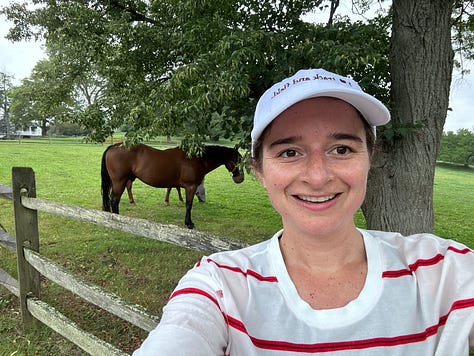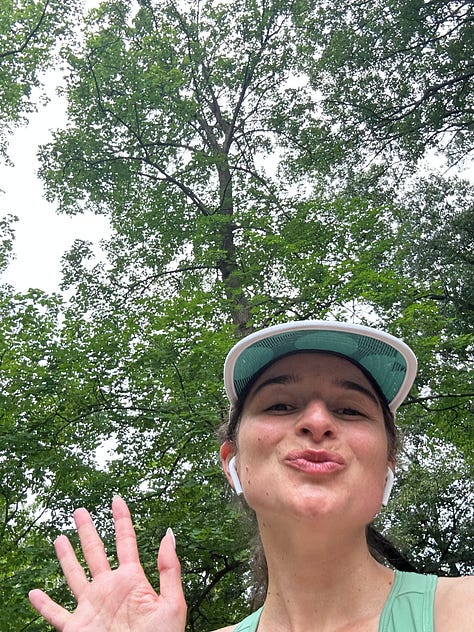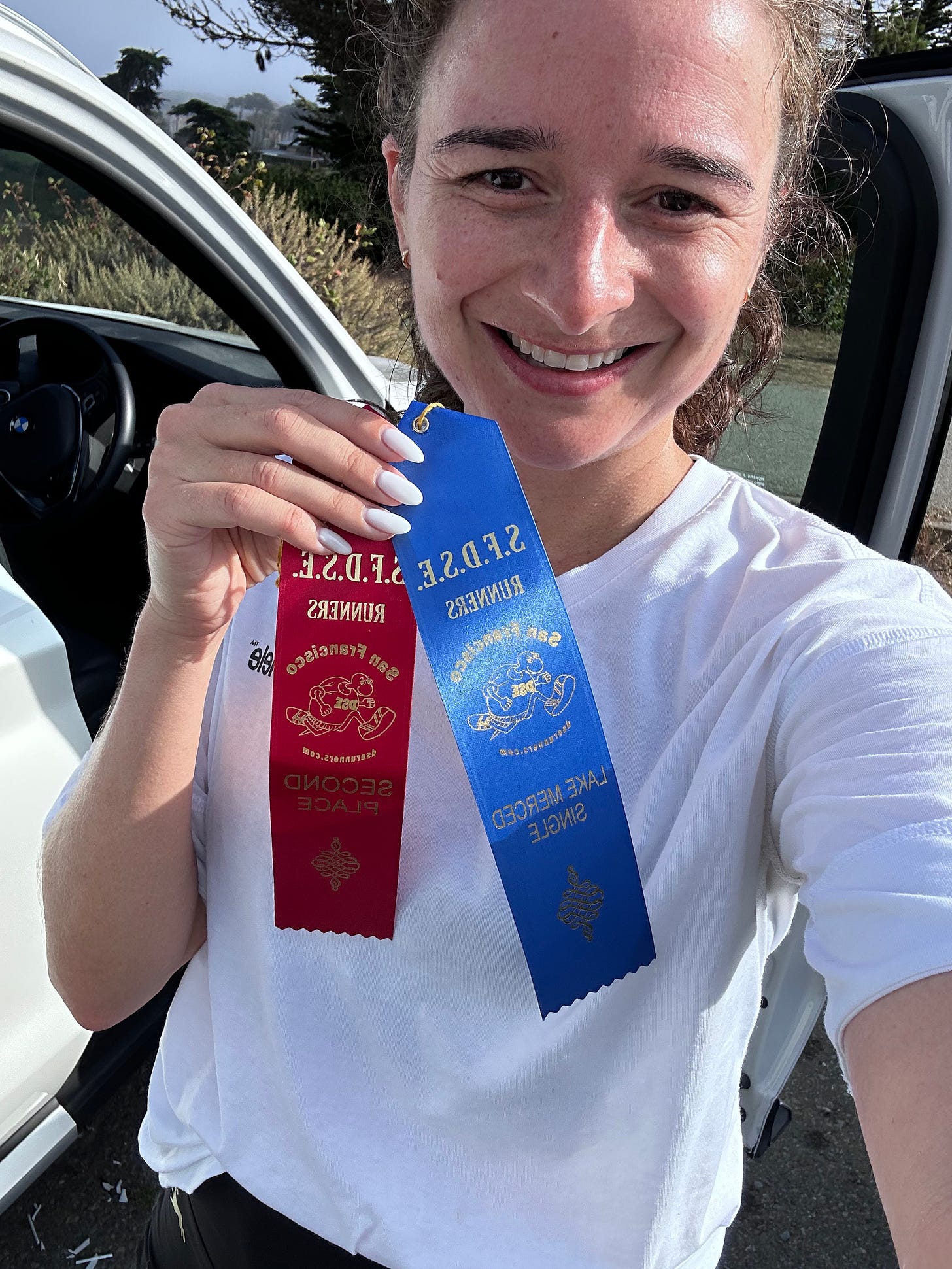


Week 4 was a step back from the intensity of the first three weeks of my marathon training plan, but a step up in beauty, greenery, and nostalgia. I did my first four runs in Sewickley, PA, hitting up my old stomping grounds: country roads, wooded trails, and my high school track. I ended the week back in San Francisco, where I did a long run today that included a 4.5 mile race with one of my favorite, volunteer-led, and very chill Bay Area run clubs: Dolphin South End Runners (their motto is “Start slowly and taper off!”). Races are a fun way for me to do up-tempo work because you can typically find a pace group to settle in with and turn off your brain, which, during an easy week, is a boon.
In this marathon training rundown, I’ll share about my down week, my love for trail running, a bit more about super shoes, and finish things off with some odds n’ ends.
📋 Total miles: 38.9 miles
Monday: 12.4 miles (steady)
Tuesday: 5.5 miles (15 min warm up, 8 x 300 w/ 90 sec rest, cool down)
Wednesday: 3.1 miles (recovery)
Thursday: 3.4 miles (progressive tempo)
Friday: Rest
Saturday: 3.4 miles (easy + 4 x 80m strides)
Sunday: 10.9 miles (included a 4.5 mile race at marathon pace)
⬇️ Down week
As you may recall, I chose a 16-week marathon training plan in preparation for the NYC Marathon. That plan is split into 4, 4-week blocks. Today I completed the base period, which had 3 progressively-more-challenging weeks followed by a week of [relative] rest.
The rest gets masked by this week’s total mileage because I completed last week’s long run on Monday. I wavered on what was more important: 7 truly lighter days or not missing a long run. I ultimately chose the latter because in marathon training, the long run is the key workout of the week. That said, I tried to keep the rest of my week light — and I even scheduled a massage for this afternoon so I can feel my best going into the next 4-week build.
This method is called periodization training, and it’s designed to keep you from being overtrained, which is a real concern for me. Despite having felt fresh and strong on the vast majority of my runs, I also have had to contend with nagging soreness, trouble sleeping, and waking up ravenous over the last month. This week of de-loading has allowed me to reset my bearings — it’s all systems go (except sleep — grrr).
🌳 Back to my roots
While my heart belongs to the track, my home is the woods. On Wednesday I returned to the trails with a high school teammate for a few easy, joyful miles. We ran a loop I’ve done 1000+ times. Despite logs, rocks, and roots, I felt sturdy on each step, as if some part of me still knows how my foot needs to land at every point along the path. (NOTE: This is far from the case for every trail. In fact, I think I would choose to go off-roads more often in the Bay if I wasn’t concerned that one bad step might be the end of my ankle.)
Most people don’t know that my background is on the trails, and I took trail running for granted in high school. It wasn’t until I learned of my college teammates’ training that I found out it was somewhat rare. I don’t know if I still receive this benefit, but in my 20s I attributed my relative hardiness to the woods. Trails provide soft and dynamic surfaces that build up strength — particularly in your foot and ankle — in a way that roads can’t. They also made me much less conscious of pace. You simply aren’t running that fast while navigating downed trees and creek beds.


🦹🏻♀️ A note on super shoes
I dropped a term last week without defining it — and I’m here to rectify! Super shoes are a class of carbon-plated, high stacked, [generally] low heel drop footwear associated with racing and fast times. A necessary disclaimer is that I am not an expert in shoe science, but I do know that the sum of these parts give you a more explosive shoe with better energy return such that each step is more powerful and simultaneously less taxing on your legs. As a user, I can assert that super shoes feel like magic.
The first time I put on my Nike Alphaflys and lightly jogged in my living room, I squealed. I wish I could relive that moment — it was absolutely delightful. I was so eager to use them on the roads that I decided to wear them at a local turkey trot a month later. I almost took them off before heading to the start line because I was self-conscious of bringing such high-tech shoes to a low-key event. Until then, I’d only seen pros and semi-pros wearing them. But to my surprise, it seemed like everyone in the race had either Alphaflys or Vaporflys — even those running at a very modest pace.
Since 2020, nearly every shoe brand has put out a super shoe. I’d suggest trying one from your favorite brand the next time you’re at a sporting goods store. They’re fun! But they’re not that durable, and they tend to be $250+/pair, so most of us leave them for when they give the biggest bang for the buck: hard workouts and races.
🧳 Odds n’ ends
Wearing: Goodr’s Mach G in Chard To Love. My eyes are like magnets for small bugs on the trail, so I was particularly grateful for these sunglasses that more-or-less cover my whole face as I frolicked in the woods.
Supplementing: Iron. I returned a ferritin level under 10 ng/mL during a blood test in June. Ideally runners want to be at 40 ng/mL or higher. Fortunately, my hemoglobin levels are normal, so I am iron deficient, but not anemic. To supplement, I’ve been taking Iron Bisglycinate which is a chelated form of iron, unlike the standard ferrous sulfate. I was introduced to this alternative because ferrous sulfate makes my stomach feel like metallic trash. With these pills, I feel nothing — and since I haven’t entirely unraveled my “no pain, no gain” mindset in therapy, I am skeptical that they’re working. I plan to get a follow up test next week to see if my levels are up.
Ignoring: Strength and mobility. This week I went to Pilates with my mom, and it was humbling. My hips, hamstrings, and right shoulder are tight, unbalanced, or not firing. I know I’m on notice.
Inspired by: The Barbie movie. There’s no obvious connection to running — I just loved it.
Ok, I’m off to refuel and refresh (aka shower) before the next cycle of hard[er] running starts tomorrow. As always, your likes, comments, and shares keep me going. I really do feel like I am running for a team.
If you want to back my run — and, more importantly, bring equitable, high-quality computer science to more students — please consider donating to my CSforAll fundraiser. No contribution is too small, and the more on the team, the merrier.
See you next Sunday!






I love the names of those special shoes: alphaflyes!
Trail running sounds so much more enjoyable than track. 😊
Re: Roots. Sewickley Heights Park looks beautiful!!!
The first photo transported me back to the trails in Wissahickon Valley Park, on the other side of the state. Surrounding oneself with Mother Nature on easy runs is the restorative cherry on top of the recovery ice cream. (Not my best metaphor...although, recovery ice cream, yum...)
Re: Light v long on the down week. No wrong choice, for a one-off switcheroo? If you had run the 12.4 miles Sunday night instead of Monday, then the mileage would have looked different on paper, but would it have been so different on body?
In any case, we've got lives to live (and plan around)! I've read that hard workouts targeting a given "system"---VO2 max, lactate threshold, and distance---should be run at least four to five days apart, to allow the body sufficient time to recover from one workout and be able to fully benefit from the next. As it happens to happen, this corporal constraint fits rather neatly into the social constraint of the seven-day week. Hence, for example, a speed workout Tuesday, a tempo workout Thursday, a long run Sunday, rinse and repeat for, oh, sixteen weeks :) Within this framework, transposing two runs while respecting the corporal constraints seems minor.
Most important is how the body reacts to and adapts to the training. We can collect and analyze tons of data, but this assessment is probably always going to be fuzzy and individual, so we also learn the fuzzy and individual skill of how to listen to our body, beyond the data. A great skill, for race day!
Re: Super shoes, iron, and periodization. I love the mini-lessons in your posts! It's like you're a pro educator or something. Keep 'em coming!